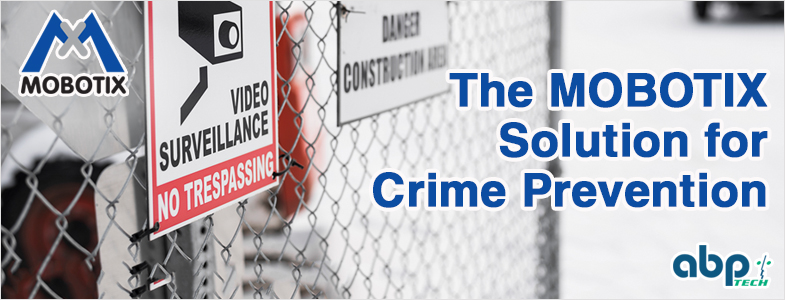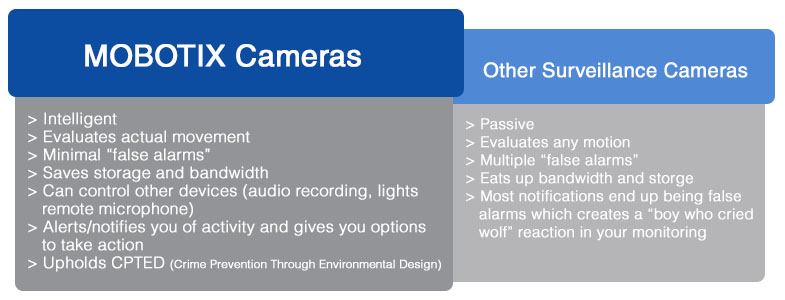Crime Prevention the MOBOTIX Way

Which side of the fence are you on?
A.) I want my security cameras to identify a suspect after an event has occurred.
B.) I want my security cameras to prevent events from occurring at my property.
The majority or security cameras out there are not intelligent enough to prevent an event from happening, so clients are being sold on concept "A." However, I believe concept "B" is the better choice.
From Reactive to Proactive: Stop Crimes Before They Happen
When I meet with video surveillance users, I hear the following statement 98% of the time, "I need cameras to identify the people stealing my copper or vandalizing my property." I then talk to them and see if post-event review is really what they want. Even if you have a great still photo of a suspect, what does that do to recover your losses? Coming from a long career in law enforcement, I can tell you the chances of solving a crime from a photo is extremely slim. Only homicides, kidnappings, robberies, sex assaults, child abductions, and missing high risk people make it to the media. Unless the detective working your case recognizes the person in the photograph, it's of no use. I then try and paint a different picture for them. I explain to them it is better to prevent the crime rather than catch the culprit. Let's say someone comes onto your property and takes $1,000 worth of copper, usually causing some $10,000 worth of damage. The crook leaves your facility and is caught down the street. Will you ever get the value of your loss back? Loss of use, possible insurance claim, and also add 3-4 days off of work to prosecute the suspect. Is it worth it?
Active vs. Passive Surveillance: Beyond Just Recording
What if you could use your surveillance product to prevent an event from happening on your property? I'm going to be speaking in terms of Crime Prevention Through Environmental Design (CPTED). In my agency, we were highly successful at reducing crime, not by catching the crooks, but by making it more difficult for the crime to even occur. In other words, why is the crime happening here and not there? Another way to look at this is, "I want to make it less inviting for the crook here, so they will choose somewhere else." For example, the addition of lighting is one effective tool. The act of adding surveillance could be a level of deterrent, but as past instances have proven, really not much. That's because almost all surveillance being pushed today is very passive. But not all surveillance cameras are passive. There are surveillance cameras that are intelligent and can control other devices. Let me use the copper theft example again. Let's say you want cameras to watch your yard for activity during the hours of 6PM and 7AM. You want to be alerted via your phone if there is any activity. You want an audible message played if there is movement detected at the perimeter of the property, such as: "Beep, Beep, Beep, Warning! You are entering a secured facility. Your activity is being monitored, authorities have been notified!" If movement is detected further into your property, you want a light or several lights automatically turned on. You can even add a blue or red strobe light to be activated at a certain point to represent law enforcement approaching. You also want to have the ability to make audible announcements with your phone, through the camera from wherever you are in the the world. Something like, "Hey, I see you in my property. I have called the police." Additionally, you want to be able to turn on lights remotely through your phone. There is a huge difference between a system like this and the systems the majority of people are being sold on.
The Problem with False Alarms and How to Reduce Them
For what I stated above to be effective, you need intelligent cameras to recognize an event. Such as someone entering your property. But the problem with the majority of camera systems is the overwhelming false alarms. Here's why, almost all cameras today use video motion windows. When pixels change inside the video motion window, it signals an event has occurred and an action to take place (such as record video). There is no exact science in setting up video motion windows. Size, sensitivity, and quantity can be different with every camera installed. There is a huge problem with using video motion windows (which every professional in the industry is aware of). One enormous issue is the "boy who cried wolf" problem, it becomes something you will eventually ignore. Not only that, but think of the needless storage and bandwidth being consumed based upon these false alarms. A staggering figure. What causes false alarms or pixel change within these video motion windows? Tree or bush moving, a cloud passing over, shake of the camera from wind, rain, fog, car lights, etc. In other words, it is an unintelligent way of monitoring a scene. An example of this intelligence is MOBOTIX's ActivitySensor (AS). AS evaluates movement, not motion. A system that can tell direction and not be fooled by a tree or bush moving, a cloud passing over, shake of the camera from wind, rain, fog, car lights. When utilizing AS, false alarms can be reduced by over 90%. Think of how you could effectively use and respond to an actual event.
So in conclusion, it is imperative for today's security professional to be asking the right questions and providing responsible solutions. Not just, "I know this product and here is a 90 degree view," done.
Blog written by: Steven Rosenbloom, MOBOTIX Business Development Manager








